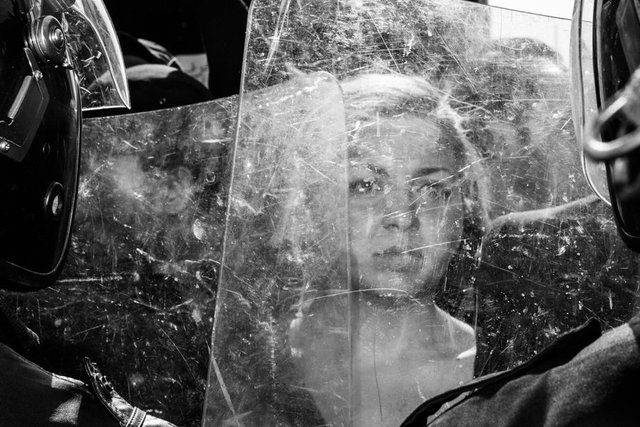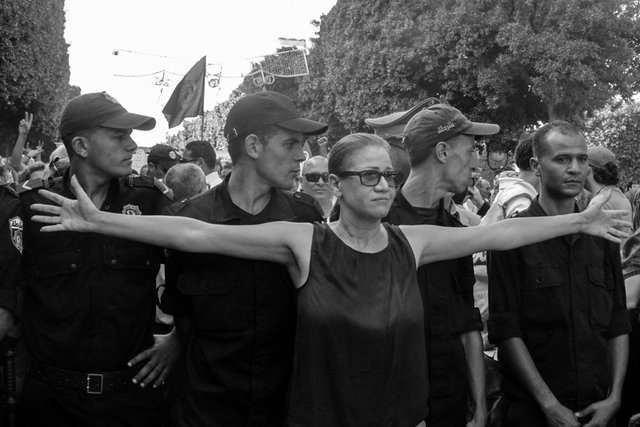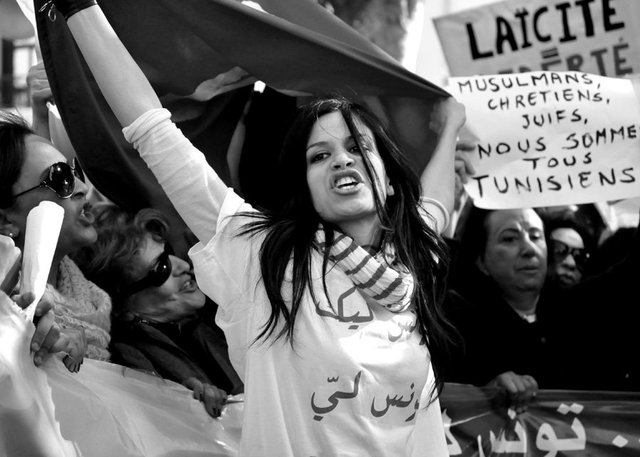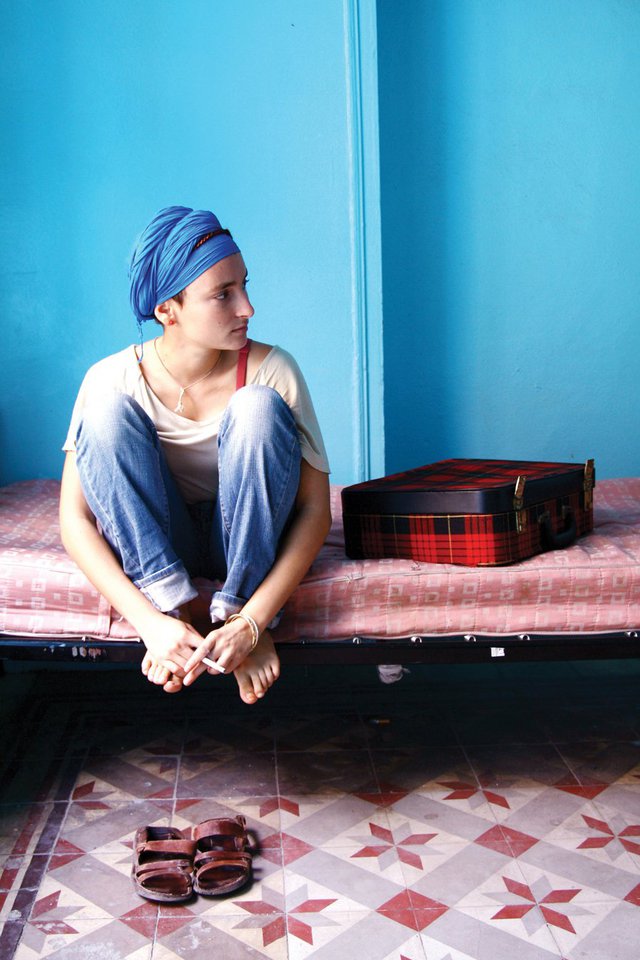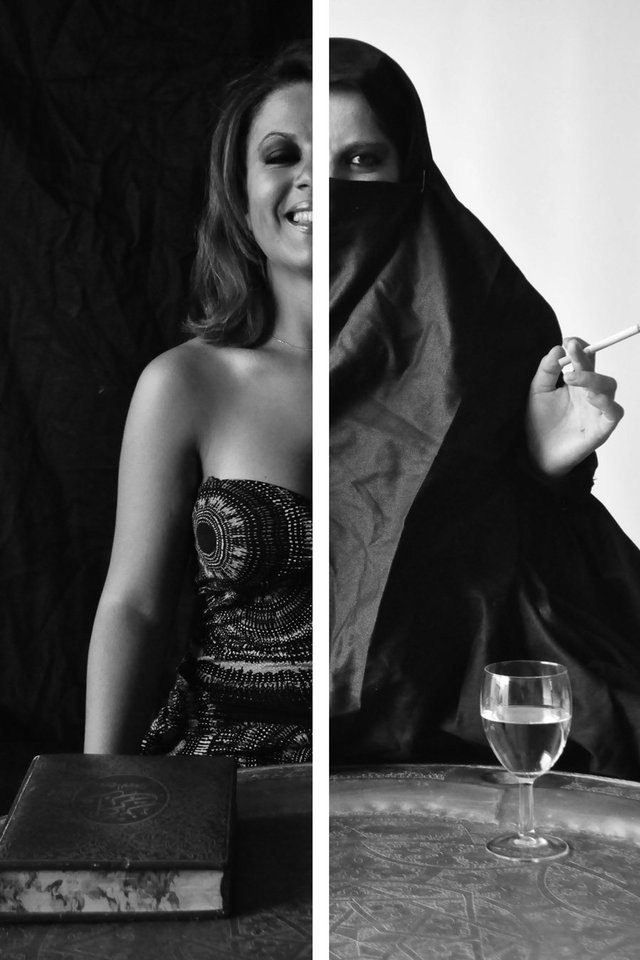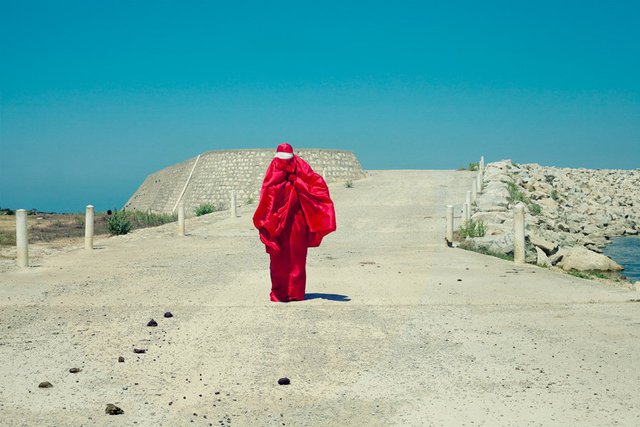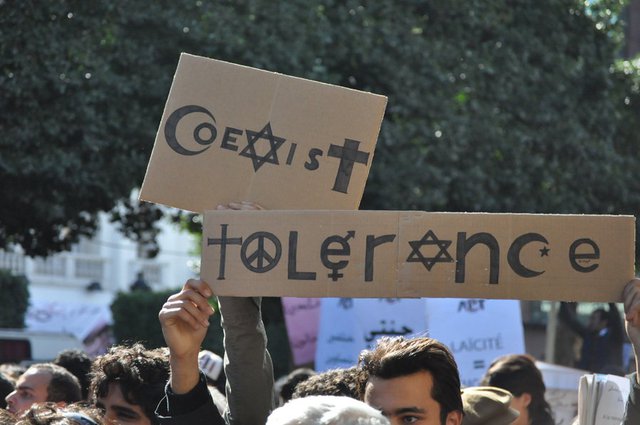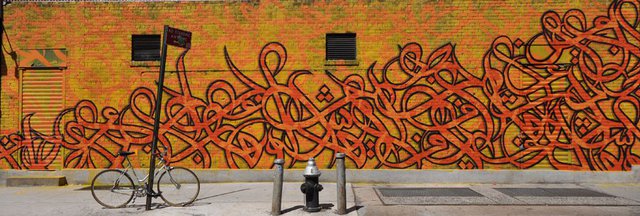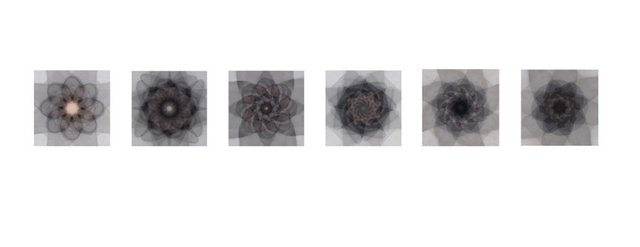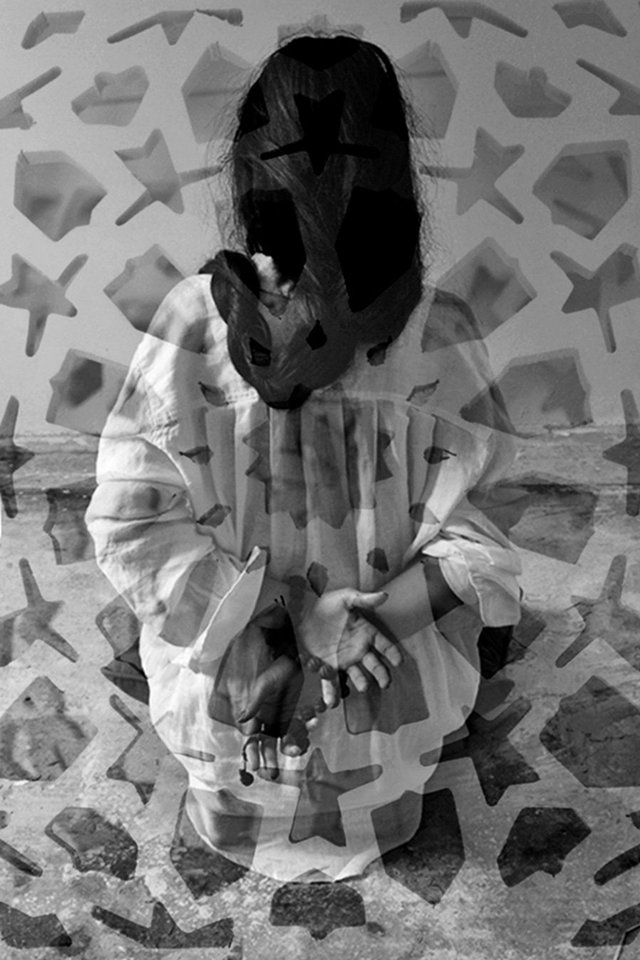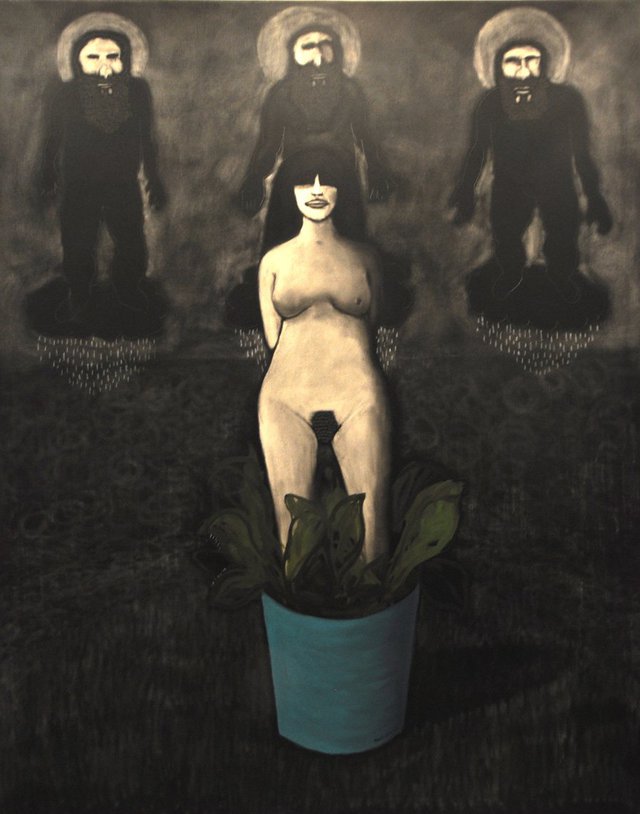Reviews
Freedom of Expression
FIAF’s 2013 World Nomads Tunisia Festival
Tunisia's artists swooped into New York during the French Institute Alliance Francaise's (FIAF) fifth edition of their biennial festival celebration of twenty-first century transculturalism: the World Nomads Festival. The impact of the institute's month-long May festival aroused an enthusiastic curiosity for this North African country, its culture heretofore little-known in America. In New York, to meet this demand, the FIAF set an international festival precedent of praiseworthy and most unusual quality. Light was cast on Tunisia's recent explosion of creativity and innovation, following the country's seminal role in the 'Arab Spring' two years ago.
There is perhaps no other African country that better symbolizes the nomadic character of cultural cross-fertilization than Tunisia, for its geographic location at the strategic northernmost tip of the African continent. Jutting out into the ancient mare nostrum has endowed it with an abundantly rich cultural history. The Tunisian author Abdelwahab Meddeb, whose work I shall discuss below in conclusion, has observed:
The Arabo-Islamic has been but one contribution to Tunisia's inherent constituent diversity, to its earlier Berber, Jewish, and African substrata, as well as the multiple Mediterranean imprints from Carthage to Rome, Andalusia to the Ottoman Empire, and, the Francophonie. (Translated from the original French)[1]
Tunisia's 2011 revolution ignited revolt upon revolt, toppling senescent dictatorships throughout parts of the Maghreb and the Near East. The effects of the Tunisian uprising continue to ripple throughout the MENA region, where oppression and abuse of human rights, suppression of democratic values and ideals, and censorship of freedom of expression, can no longer be tolerated if those nations wish to advance and flourish. In the context of the festival, how Tunisian artists expressed and documented their country's historic tumult, and reflected upon its current constitutional debate – especially the need for the incontrovertible reestablishment of equal rights – was often revelatory and breathtaking.
The FIAF's complex programming, in collaboration with Tunisian curators, seems to have been a long, creative, analytical process, where the geographical evolved into thematic logic: an exploration of the nature of Tunisia's nomadism entwined with the role of women in art, society and politics, and – what was of urgent concern – post-revolutionary conditions of state repression. Sub-themes were interwoven: resistance and protest; consciousness-raising; and the need for peaceful, spiritual solutions in Islamic society.
The festival was a synthesis of Tunisia's culture in its modernization process. Disquieting in some instances, curatorial selections evoked revolutionary zeal and activism through visual arts, music, dance, cinema, and through ancillary women's panel discussions, with coherent vision. This all served to reveal Tunisia's decades-long history as one of the most progressive and open-minded of the Arab countries, although its current and incumbent theocratic-oriented political configuration threatens to undermine progress. In order to paint a picture of the creative scene in Tunisia as presented by the FIAF, this review will consider all aspects of the World Nomads Festival in 2013 according to discipline.
Tunisian Visual Arts in New York
Running deliberately and rebelliously against the grain of fundamentalist clerical interpretation of Islamic Law, where contemporary visual arts are throttled by harsh censorship and restrictions, the festival exhibitions bore powerful witness to the ongoing struggle for democratic freedom of expression in Tunisia today. Curator Leila Souissi featured 14 artists in various media, from photography to painting, videography, and 'calligrafitti', under the title The After Revolution. Under this rubric, the FIAF's former Visual Arts Director and current White Box Executive Director, Antoine Guerrero, helped position various exhibits in specific New York arts venues with a reputation for being contextually hip and cutting-edge.
At the White Box Art Center in Manhattan's Lower East Side, the entrance to the photography exhibit carried the following signage:
World Nomads Tunisia: The After Revolution: After the events of January 2011, Tunisia has experienced radical economic, societal, and artistic change. Artists were the first to react to this upheaval and threw off entrenched prohibitions to embrace free expression in all the areas of art. Despite lingering unrest and disturbance that left some faced with exile and destruction of their artworks, these artists continue to resist and fight for their freedom…Some of the works in New York are prohibited in Tunisia. This exhibition features work by Amine Boussoffara, Wassim Ghozlani, Amine Landoulsi, Zied Ben Romdhane, Rim Temimi, and Patricia Triki.
The exhibit presented some of Tunisia's immensely gifted photographers, all of whom brilliantly documented the unfolding of events leading to the overthrow of the former regime, as well as the aftermath of the revolution. There was Amine Boussofara's Dégage (2011), Amine Landoulsi's Madonna (2012) and Stop (2012), Patricia Triki's Untitled, from the series Sabrina b.h.a. (2008), and above all, Rim Temimi's ni qab ni soumise (2010), Tuniversality (2011), and Coexist (2011). Bracing and iconic, the majority black-and-white images presented by all the artists captured the heart of Tunisia's revolution, from expressions of anger, irony, anxiety and perplexity, to a fervent desire for better days to come, fleeting moments of pensiveness, and the birthing of a new identity, as well as a new nation to be.
Most remarkable were the depictions and portraits of the adamantly assertive force of women in the revolution and in society. For the most part, the absence of defiance against veiling and headscarves in imagery seemed to reflect a profound inquiry into the Wahhabi movement and its dictates concerning control over a woman's mind and body. In a profound counterpoint, the subtle, spiritual dialectic of Sufi philosophy – of moderation, circumscribing coexistence, tolerance, and peace – emerged continuously in works by Rim Temimi, Wassim Ghozlani, Amine Landoulsi, and Zied Ben Romdhane.
Simultaneous to the White Box photography show, 'calligrafitti' artists eL Seed and Jaye created a live outdoor painting event directly across the street, covering a blank building and the corner walls of Broome and Chrystie Streets with magnificent, brilliantly coloured, elaborate codes. The contrast between eL Seed's sharply chiselled, curvilinear Arabic calligraphy and Jaye's blooming, bubble-like text in English was as much a call-and-response graffiti dialogue as it was an elevation of thought. One image by eL Seed was the Arabic translation of Francis Picabia's pronouncement 'one must be a nomad', and 'go through ideas as through lands and cities….', while a second work was a calligraphic rendering of 'the more you go to the West, the more you reach the East', a saying attributed to Lao Tzu. Another work in English by Jaye, quoted Einstein's 'imagination is more important than knowledge.'
Although the meanings of their word imagery may seem pertinent, their combined colour, design, composition and layout seized the eye immediately. And of course, the ever-savvy FIAF organized yet more astonishing outdoor wall-painting events for the duo at the legendary 5Pointz Aerosol Art Center, the hip-hop 'graffiti Mecca' in Long Island City, as well as at the New Museum's Ideas City Festival.
In the FIAF's own gallery space, Leila Souissi presented five artists expanding on her theme of 'The After Revolution' through mixed media: painting, photography, and videography. The exhibition's unity lay in its contemplation of the aesthetics of revolution following January 2011. This included the resistance against the Salafist prohibition of the portrayal of women's images, and the refusal to submit to Salafist theocratic authority.
The most aesthetically pleasing of the works were the softly feminine, dreamlike photographic images of women in Mouna Jamel Siala's Rosaces series (2013). Reminiscent of centred Mandalas, these were an iconography of revolving, diaphanous veilings of gentle, shadow petals concealing and revealing Siala's self-portrait. Then there was Hela Ammar's cryptic Beyond The Walls (2011) series: portraits of a woman seated, kneeling, face-on and from behind, sometimes holding a large key; avoiding direct gaze with the camera, yet clearly visible through superimposed transparent layers of zellige and mashrabiyya patterns.
Direct condemnation and contempt of Salafist censorship lay in the work of two painters, including Amel Ben Attia with his work In the Name of the Lord (2013), a mixed-media diptych of two squared, mostly black canvases. In the foreground of the picture on the left, the silhouette of a woman's nude body lay in a semi-foetal position, shielding her back from knife-like piercings emanating from the Salafist flag and words taken from the Salafist manifesto rendered in the background. In the picture on the right there was another silhouette: a white, domed structure – a mosque or zāwiya – with its doors bearing the outlines of the Star of David, defaced by the red stamp of censorship. To the right of the domed structure, a small frame contained the word 'censorship' in red. In both images, the 99 names of Allah in a white, calligraphy script were scratched over the blackened background to produce a Twombly-like surface texture.
While this exhibition was intended to feature predominantly women – presently the most vulnerable sector of Tunisian society following the revolutions due to sudden and violent Salafist repression –- Souissi included one male painter: Mohamed Ben Slama. He is by now a cause célèbre; he fled to Paris, a symbol of the intimidation and censorship facing artists in Tunisia. In May 2012 his work Lamb Couscous, a portrait of a nude woman with a bowl of couscous covering her pubis, was deemed blasphemous by the radical movement The League for the Protection of the Revolution. The painting was vandalized and seized by the police.
Ben Slama's dark paintings are modern day Boschs, dominated by bearded, devilish, monster-like figures, referencing the government's collusion with clerical authority. The most startling of the four works on show was In God We Trust (2013), a wonderful portrait of another nude woman implanted in a flowerpot of green leaves. On her pubis is finely etched: 'In God We Trust'. To her rear, three, haloed, bearded male figures menace her enigmatic smile (or is it a smirk?). In this, Ben Slama stubbornly depicts the deeply troubling sexual psychopathology of religious fundamentalism.
A Festival of Tunisian Music
Nowhere more distinctly did the World Nomads Festival reflect Tunisia's nomadism than in the FIAF's delightful programming of music and dance. With refinement and connoisseurship, Paris-based Karim Maatoug served as a key advisor to the festival concerning the presentations of performing arts that took place at the FIAF's Florence Gould Hall. Here, Tunisia's musical capacity to devastate was struck with deadly aim. Three of the country's most cherished singers represented dazzling facets of a vibrant musical scene: Sonia M'Barek, classical Andalusian-Mediterranean; Ghalia Benali, contemporary world soul; and Emel Mathlouthi, the revolutionary ethos.
Sonia M'Barek's concert, presented by the FIAF and the World Music Institute, embraced the classical Arab cultural concept of tarab, the intimate union of ecstasy shared between musician and listener. She wove Tunisia's traditional Al-Andalus style known as malouf effortlessly together with musical strands from around the Mediterranean, summoning memories of medieval Andalusia, Ottoman court song, Federico Garcia Lorca, and some of Tunisia's celebrated twentieth-century poets and composers. North America's finessed Near Eastern chamber ensemble, the Al-Bustan Takht Ensemble (which comprises violin, percussion, cello, and oud), accompanied her soaring, quivering, soprano vocals.
M'Barek performed with elegant restraint, moving from melancholic longing to light-hearted felicity. With solemnity, she sang acappella lyrics by the Tunisian poet Mnaouer Smadeh, 'Al-Kalimāt' (The Power of Words), a paean to Arab peoples who must have the courage to speak up, even at the risk of death. One of her loveliest interpretations fused two songs, 'Layali Ishbilya' (Nights of Seville) and 'Hobbi Yetbadel Yedjadid' (My Love is Renewed), in homage to the late Tunisian composer and singer Hedi Jouini, who was influenced by flamenco's deepest forms in the Andalusian cante jondo. Here, as in the entire evening's repertoire, her embellishment of malouf with improvisational ardour elevated the performance.
The long-awaited US debut of Ghalia Benali was a splendid and joyous triumph. Warm, charming and worldly, there are few stars capable of entertaining through combined song and performance with such élanand imagination. Immensely popular at home in the Arab world, and in parts of Europe, her concert reflected her nomadism, mysticism, and modernity. An original storyteller, she drew from her well-spring of knowledge of Indian and Sufi music and mysticism, calling on the brooding soul of Oum Kalthoum, ancient love allegories, and of Latin jazz with Middle Eastern inflections, to produce a performance with kaleidoscopic tonal colour, rhythm and shifting mood.
Dressed in a billowing, hoop-skirted white gown and plumed headdress, Benali appeared on stage as a fairy princess with utter regal command. Intoning 'Aman, Aman, Aman' ('Mercy, Mercy…' or also, a state of spiritual grace…), she launched into one of twelfth century Arab-Andalusia's most famous songs: 'Lama Bada Ytathana'. It includes the lyrics: 'Oh, my destiny, oh, my perplexity / who can answer my lament of love and distress / but the graceful one, the one of beauty?' The costume Benali wore to open the show was drawn from her own allegorical theatre piece Romeo and Leila, an enchanting autobiographical account of her quest in search of the self. Shedding her gown, she stepped out as the 'modern Ghalia' – coolly self-confident and liberated, mesmerizing the crowds with undulating dance movement, even reappropriating 'Caravan' and 'A Night in Tunisia', blending Latin syncopation with sinuous Arab rhythms. Backed by an excellent group of New York-based musicians, equally at ease with semi-classical Arab orchestration, jazz, and experimental (cello, violin, clarinet, saxophone, shakuhachi, bass and drums), Benali created a sense of sustained dramatic tension with her gliding vocal range, from mezzo-soprano to contralto. 'We are born to love, to be loved', she reminded the audience, as she spun forth the circular trance-like rhythms of 'Hayamatni'. The song was once sung by Syria's tarab master Sabah Fakhri, but Benali made it thoroughly her own.
To top off the evening, the Tunisian DJ collective Waveform presided over a euphoric electronic trance dance party at Catch Roof. Their set was filled with refracting, pulsing, bass-line shadows, crackling glints and strobing buzzes, with a sensuously urgent undertow of beat textures and omni-directional sound sensations.
Tunisia's most impressive, emblematic voice of the 'Arab Spring', Emel Mathlouthi, also made her US debut in the final concert of the festival. Her song 'Kelmti Horra' (My Word is Free), also the title of her 2012 international album, has become a revolutionary anthem for Arab countries. 'It has been praised as an artistic achievement as well as for its significant, historical meaning,' Marie-Monique Steckel, FIAF President, noted in her introduction to the performance.
Mathlouthi clearly joins the ranks of world protest singers who perform in the defence of freedom, justice, and human dignity. Hers is a fierce voice of conviction, which stems from her talent as a singer-songwriter. Steeped in the traditions of rock and electronica, she is drawn to the socially conscious lyrics of Dylan, Baez, Bjork and Marcel Khalife, and has absorbed the modes, phrasings, and keys with clarity and ease. Sweet, crystalline vocals hovered and cascaded over resonant ostinatos and chord progressions, self-accompanied on guitar and by her pianist and guitarist. Using pedals, she created gentle auras of loops and echoes, enveloping her voice with understated effect. A show-stopping moment occurred when she filled the hall with Leonard Cohen's 'Hallelujah'. The spellbound audience was a prayer-like chorus, as her nuanced tremolos rose in radiant crescendo.
The entire concert, mostly selections from Mathlouthi's album, was one of mourning for the martyrs of the revolution. It expressed steadfast solidarity with people yearning to be free; yearning for love's redemption; and a promising new voice of hope and inspiration for the youth now in search of a strong Tunisian identity.
Dance Moves
Both dance performances were US premieres by the internationally acclaimed choreographer-dancers Jonah Bokaer and Radhouane El Meddeb. Dovetailing within the context of the festival, their themes – the nomadic soul and the cultural identity of women – intersected neatly.
Tunisian-American Jonah Bokaer's 'The Ulysses Syndrome' was a minimalist duet, layered with meaning, between himself and his Tunisian father Tsvi Bokaer, a screenwriter. While the intriguing title invokes the Homeric hero Odysseus, King of Ithaca, and his long journey home following the Trojan War, it also refers to the psychic trauma of dislocation, alienation, and isolation felt by immigrants, travellers, expatriates and exiles.
Father and son in collaboration transposed their personal experiences to the piece, shaping its structure and content. Tsvi, the father, provided a text in 12-part cantos, Le Danseur Errant et la Méditerranée (The Wandering Dancer and the Mediterranean). They are his memories of the Mediterranean and the nomadic life he lived before settling in Ithaca, New York. The son, in search of deeper understanding of his father's cantos and the nature of his wandering soul, travelled to Tunisia in early 2013. His observations of the culture, including hexagons in tiles and friezes seen in the Musée Bardo, informed the stage design and the pace of the movement.
The fascinating hour-long choreography explored both the physical and emotional issues of psychic disorientation and the father-son relationship. The contrast in movement between the two men was a dialogue, intuitive and empathetic. The vigilant father's reassuringly benevolent presence was expressed with spare movement, while Jonah's metaphorical choreography in relation to the struggle and anguish of the artist in search of his art recalled what Tarkovsky once described as the artist's 'urge to create'.
The ambient soundscape was the Soundwalk Collective's compilation of sounds collected around the Mediterranean basin and North African coastline: the ocean itself dissolving time and memory. There were radio interceptions along the shores; street traffic; the music of crickets; roosters crowing; twinkling kora and balaphon; children playing; whisperings in Arabic; rumbling guimbri; an Andalusian dance rhythm; an ocean liner's baleful mourn; a woman's silken voice in song; the ebb and flow of waves…
Radhouane El Meddeb's riveting solo dance Sous leurs pieds, le paradis (Under Their Feet, Paradise), co-choreographed by Thomas Lebrun, paid homage to heroines, mothers, daughters and sisters. The title of the performance referenced the Islamic hadith: 'Paradise is found under the feet of mothers', and was set to a live recording of Oum Kalthoum's 'Al-Atlal' (The Ruins), considered an apotheosis in tarab tradition. The song-poem is Kalthoum's virtuosic avowal of the tyranny of desire, and, in its uninhibited temerity, an unveiling of the passion in women. The intense precision of El Meddeb's movement, yielding, falling into rapture to the ear-splitting roar of Kalthoum's frenzied audience reaching a state of saltanah (higherecstatic emotional surrender) was genius. There were the frantic convulsions, as if exorcising his male identity; the repossessive and possessive of the female. El Meddeb's expressive hands continually formed hieroglyphic cues – 'A bird of desire singing my pain', 'I, wandering in love, a bewildered butterfly', as if his femininity yearned and swooned in a performance that explored the feminine. The black staging curtains and a long white swath of sheeting, which El Meddeb used to conceal and expose his body, were part of his lyricism. It was an exceptional union of poetry, music, and dance: a masterful study in the aesthetics of gender.
Cinematic Revolutions
Dora Bouchoucha, historically Tunisia's very first female producer, curated the month-long series 'Tunisia in Film'. The startling features and disturbing documentaries provided trenchant insights into the causes and underlying conditions leading to the revolution. Spanning the decades from pre-independence through to pre-revolution, the three feature storylines traced the oppression, abuse, corruption, and hypocrisy of power, almost a subconscious commentary on pre-revolutionary political censorship. In 1994, the release The Silences of the Palace by the Arab world's first woman director, Tunisian Moufida Tlatli, framed Tunisia's struggle for independence in the 1950s with the heroine Alia's post-independence search for self-liberation.
The film is a sumptuous visual brocade of intertwined stories. The protagonist Alia, in flashback sequences of her childhood and adolescence, relives the tale of her mother's oppression as a palace servant: the decadent sexual abuse by Bey princes and her desperate attempt to abort a pregnancy resulting from rape. Alia, ten years later as a young woman, faces the illusion of her freedom with a lover who tries to force her to abort their child. The reflection from the film as it is revisited today, post-2011, gives pause for thought. Its critique works as an exposé of the ongoing struggle for women's rights and an investigation into the ambiguity of freedom. Meanwhile, Raja Amari's Red Satin (2002) and Buried Secrets (2009) explored other facets of oppression through more female protagonists. Red Satin's heroine, a widowed seamstress, is at first bound up by self-repression and society's stifling norms of class and morality. Her will breaks through these psychological impositions as her overwhelming sensuality leads her to a men's nightclub with bar dancers. Through convoluted twists it comes to a happy ending, in stark contrast to Bouchoucha's Buried Secrets – a grotesque horror story about poverty. Bouchoucha has described the film as 'what happens to people when they are oppressed, they become monsters.' A homeless mother and her two daughters sink deeper and deeper into a co-dependent triangle of madness. These are the impoverished and hopeless outcasts of society. Liberation from poverty, a cunning tormentor of the mind, involves inevitable, tragic revolt.
There were also documentary screenings, recognizing the growing presence of the form in cinematic practices, including Hinde Boujemaa's It Was Better Tomorrow (2012) and Sami Tlili's Cursed Be The Phosphate (2012). In It Was Better Tomorrow, Bouchoucha and Boujemaa followed and documented the life of a homeless Tunisian mother, Aida, and her mentally impaired son over the course of a year. A heart-rending testimonial to her courage in the face of destitution and despair, it serves as an indictment of the state's impotence. She lives as a squatter, receives little welfare or care from the state, is jailed for alleged theft, and occasionally finds work.
Cursed Be The Phosphate (2012) is an elegy to the protesters in the Gafsa mining basin in the south of Tunisia. Many were murdered or imprisoned as part of brutal state oppression in 2008 following labour disputes concerning unsafe working conditions and worker exploitation by the Ben Ali regime. Four years later, following this 'revolt for dignity' – an historical juncture and actual inspiration for the 2011 Tunisian Revolution – the director returned to the basin to uncover and honour the truth, while paying respect to those victims (or heroes and martyrs) of the revolution.
During a series of talks with some of Tunisia's dynamic women leaders on the country's artistic, social and political transformation, Bouchoucha, was a cogent speaker, offering positive insights about the historical and current role of women as drivers and instigators of change.
Literature Redux
What would knowledge of a country's culture be without its literature? Delving into the FIAF's fine library, where one can find scholarly analyses of Tunisian and Maghrebi culture and literature, I came across one study whose perusal of the country's contemporary literature made several references to the writing of Abdelwahab Meddeb. Meddeb is a foremost French-language novelist, poet, essayist, and cultural critic. The quotations held such distinctive perceptions and language styles that they provoked my immediate search for some of his many books. Four have been translated into English: The Malady of Islam (2003), Tombeau of Ibn Arabi and White Traverses (2010), Talismano (2011), and Islam and the Challenge of Civilization (2013).
Over the past few decades, Abdelwahab Meddeb, a most compelling polymath from the Maghreb, has emerged as a leading authority on Islamic culture and civilization, a vigorous critic of fundamentalism, and a relentless champion of secularism. As the genial radio host of France Culture's Cultures d'Islam, his weekly hour-long programmes are a wealth of erudition, covering historical and contemporary subjects from Sufi philosophy to the arts and political ideology.
Talismano is a superlative reading experience in modernist literature. It is all the more astounding to realize that the novel appeared originally in 1976, and in 1986 in revision. During a young man's picaresque journey back to Tunis, Meddeb's childhood city of birth, semi-autobiographical allusions collide with the phantasmagorical nature of his imagination, supernatural revelation, and pagan superstition. The city's labyrinthine medina develops as a metaphor for the eternally nomadic mind, where polyphonies of memories of other times, other people, and other places travelled, constantly overlap and echo back and forth with musical intensities. A multilingual master of tempo, meter, and dramatic trajectory, Meddeb shears away at extraneous syntax, and, in the process, invents his own language.
In fleeting passages of invectives and incisive observations of tyranny and the injustices of class and religion – sometimes infused with a sense of irrepressible, ribald amusement – Meddeb may well have foreseen, Sybil-like, the coming of the Tunisian Revolution. Yet timelessness lies in the art of his incantatory prose that reaches beyond the profane towards the sacred. In Talismano, Meddeb is in the company of James Joyce, transporting the reader to North Africa's fabled city, Tunis, in unparalleled sensorial splendour.
And finally…
The Sibyl, with frenzied mouth uttering grave things, unadorned and unembellished, reaches out over a thousand years with her voice because of the god in her.
– Heraclitus, Fragment 92.
In closing this unabashed appreciation of Tunisia's arts, first introduced to me by the FIAF's World Nomads Tunisia Festival, I wish to draw on Abdelwahab Meddeb's Tombeau of Ibn Arabi. In this lyrical meditation, Meddeb enters into simultaneous dialogue with the medieval Sufi poet Ibn Arabi and Dante, both progenitors '…in the long history of exaltation of women by men...', [2] who discovered portals to the mystical divine through the celebration of earthly love. As Meddeb writes:
In unison we chanted the threnody, at the foot of a dry tree, and the wind spread another lament, which woke desire in us, light reaching us from beyond the mountains, night covered with dew, we shared our fruits… the fires of our bodies lured a bestiary, the red antelope, the black-and-white heifer, tinged with henna, their eyes, at night, invented in the middle of the desert, a meadow where they gamboled, before coming back luxuriant, to the enclosure of our enchanted garden, it was the night of transformation, forms shifted and changed, and I felt able to welcome them all, I saw myself wandering through lands, mumbling all languages, handling all writings, entering and exiting, according to chance meetings, going from one scene to another, marvelling at the vestiges of peoples, traveling at times, erratic, moving, changing, in the mirror of metamorphoses, at the mercy of passion which runs the world.[3]

